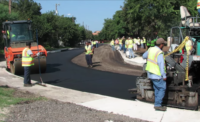Ten Minutes with Greg Steele, Arcadis Mobility Unit President

Greg Steele leads Arcadis mobility and sustainability efforts across the globe.
Photo courtesy of Arcadis
Greg Steele is Global President of the Mobility Business Area for engineering giant Arcadis. The mobility unit employs more than 6,000 people spread across 12 countries. He has about 15 years of C-suite-level experience in global organizations focused on transport, mobility and infrastructure. Steele also is co-chair of the World Business Council for Sustainable Development’s Transport & Mobility Pathway and chair of Engineering Aid Australia, which supports First Nations youth in pursuing careers in engineering or technology.
Steele spoke with Aileen Cho, ENR deputy editor for infrastructure, about key projects and the future of mobility. This interview has been edited and condensed.
ENR: How did you get into this space?
It's in my DNA. I’ve been a civil engineer for 40 years—the first 10 in government—always in mobility, be it highways or rail. I did a lot of transport planning, then became a consultant. When Arcadis restructured four years ago as a global business, I was asked to take on mobility.
What are the big mobility trends?
Electric vertical take-offs and landings (eVTOL)—Jetsons-type stuff is one. We're working with the San Diego Association of Governments (SANDAG) and private-sector companies on new modes of transport such as autonomous pods. Active mobility is huge as the world tries to decarbonize. Walking, cycling, e-scooters—all are a trend around the world. Mobility hubs—cities and precincts with car-free zones—they're prevalent in the Netherlands.
What about The Future of Fifth in New York City?
It's in the early phases. We're aiming for a boulevard akin to the Avenue des Champs-Élysées. The idea is to create shade, vegetation as a relief from heat, a pedestrian-friendly environment for locals and tourists and a precinct that attracts revenue and finance. There is lots of stakeholder engagement. We're working through how it may happen. Mobility and traffic and bikes and pedestrians, and also architecture – making it look and feel good. It goes down to details of planting.
I'm in New York now for New York Climate Week. I chair the transport and mobility pathway [group]. Many members come together to do work and take on challenges. We worked with [Japanese IT equipment and services firm] Fujitsu Ltd. on a project in London—if everyone shared data, what would that look like? Could we coordinate services, travel data? For example, electric vehicle infrastructure—we could save 15% on its costs if we coordinated. We're looking at EV bus corridors in places like India, Brazil and Mexico. This week, I've been talking with financiers, private-sector operators, Amazon and [original equipment manufacturers].
Tell me more about Engineering Aid Australia.
I've been chair of Engineering Aid Australia for eight years. It's been around for 25 years. We encourage First Nations [youth] to become engineers. Some 1,500 students have gone through the program and 25% have become engineers. We bring them from remote areas to big cities and immerse them for a whole week in projects. It opens up their eyes to the possibilities. The goal is to ignite big dreams among indigenous youth.
Do you believe that in the future, cities really can be net-zero?
I do believe future cities can be net-zero. They can be automated and coordinated. Reducing [vehicle] trips is the best thing we can do. We're working with the northern area of the Netherlands—a region that is working to manage traffic to get to net zero over a 10-year period.
What about the San Fernando Valley Light Rail Project?
We’re the construction manager for the first piece of new light rail in that region in the last 20 years. Among members of that community, 35% don’t have access to vehicles and rely heavily on transit. The social bit is so critical. It will enable people to have equal access to jobs and education.
And of course, Arcadis is involved with the Hudson Rivers Tunnels project ...
It's one of the biggest in the world. For Gateway Development Commission as delivery partner with Mace and Parsons, we're looking at what’s the most effective way to deliver packages [related to] timing and cost management. All those elements are in our control. It’s complex. I learned today about a bulkhead wall built by the Dutch in the 1890s that the [project] tunnel boring machine has to go through. Barges are out there doing soil strengthening. Arcadis [started out as] a Dutch firm, so it's like coming full circle.



